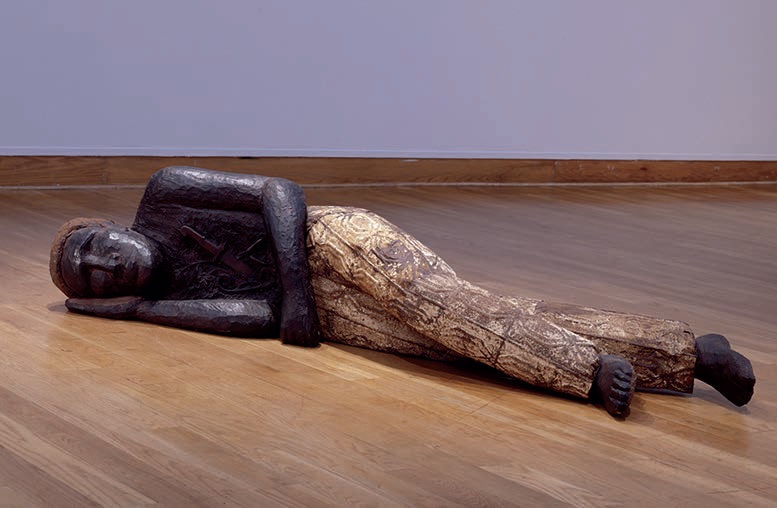
Alison Saar
American, 1956-
Terra Firma, 1991
wood, tin, tar, found objects
18 x 74 x 22 in.
SBMA, Museum Purchase, with funds provided by the Twentieth-Century Art Acquisition Fund and the SBMA Friends of Contemporary Art in celebration of the Museum's 50th Anniversary
1992.20

Alison Saar - undated photo
“I wanted to make art that told a story, that would engage people. I wanted them to be moved by my work, whether it was specifically what my intentions were or not did not matter. I wanted them to be drawn in and affected by my sculpture.” - Alison Saar
COMMENTS
While Alison Saar lived in New York in the 1980s and 1990s, the homeless population swelled as economic forces eliminated jobs and income. Mental care facilities closed; former patients fended for themselves on the streets. During winter, people slept on grates in the sidewalks for warmth from the heat rising from the subway system below. Any sense of security disappeared for many. Saar’s sculpture "Terra Firma" was made while the artist lived in an industrial area of Chelsea in New York. Buildings there were being renovated as gentrification set in.
Saar rescued media for this sculpture from dumpsters filled with old construction materials. Gluing old floorboards together, she fabricated blocks of wood that were carved to shape the figure. She used sections of patterned tin, previously used on ceilings and walls, to create pants. She attached found objects to the torso. The figure’s chest area was filled with objects for empowerment and protection, as African artists do in creating ritual spirit objects known as Nkisi. An ornamental cast iron rose, part of a gate, reflected both the past and hope for the future. Her use of tar on the body signified skin color. It also suggested the history of tar baby as a derogatory term for African Americans.
Together image and materials powerfully became an indicator of race, class, and economic conditions. In light of current racial tension and wealth disparity, "Terra Firma" remains as potent today as when it was created. It is an iconic American artwork.
Instead of giving us an anchor, "Terra Firma" rattles the status quo, unleashing uncomfortable questions: Who ends up on the street and why? In an era of extreme wealth, why is there hunger and homelessness? Why are African Americans, in particular, victims of major economic discrepancies? What is our responsibility in all this? How close are any of us to being on the street?
Saar is a member of an eminent American art family. Previous families of talent, such as the Peales and the Wyeths, were painters based in the eastern United States, working in Northern European traditions and rooted in patriarchy. The Saar family, however, centered far from Europe in Los Angeles, represents an evolution of the American experience. It is multiracial, multimedia, and matriarchal. Along with her mother, artist Betye Saar, and sisters, artist Lezley and writer Trayce, Alison Saar offers up a complex, full vision of contemporary America.
- Dane Goodman, Artist and Independent Curator, in "75 in 25", SBMA, 2016, p.246
SBMA CURATORIAL LABELS
Integrating both found objects and traditional artistic materials, Alison Saar’s work addresses a range of experiences related to the African diaspora, femininity, and cultural and social identity. Carved with a chainsaw, "Terra Firma" depicts a life-size, prone figure painted in earthen colors and clad with metal sheathing collected from tin roofs of urban demolition sites. The resulting sculpture recognizes the persistence of poverty and homelessness, and becomes a powerful totem for humanity.
- Ridley-Tree Rotation, 2018
